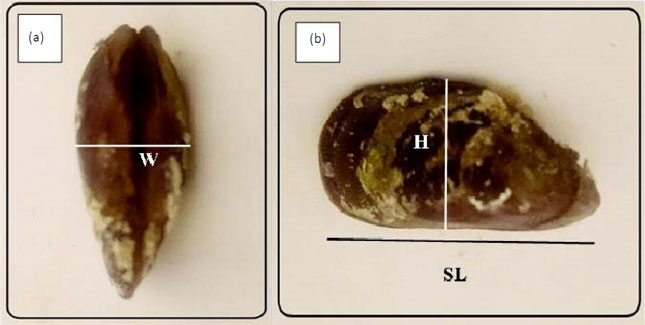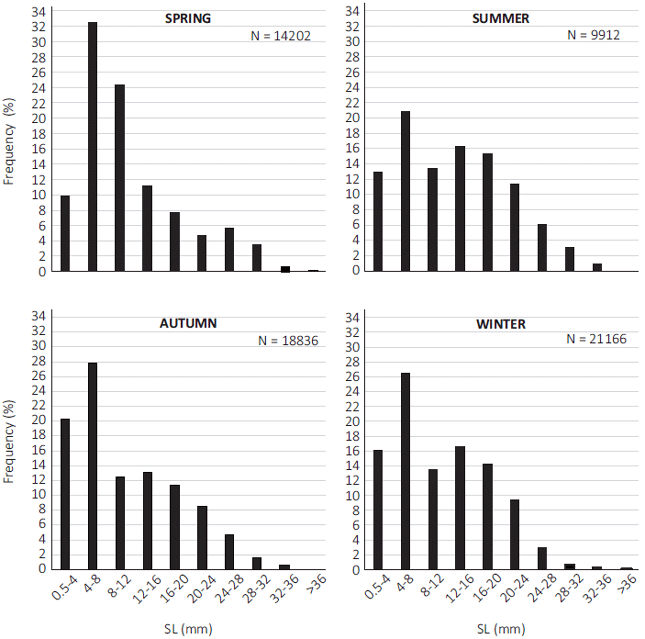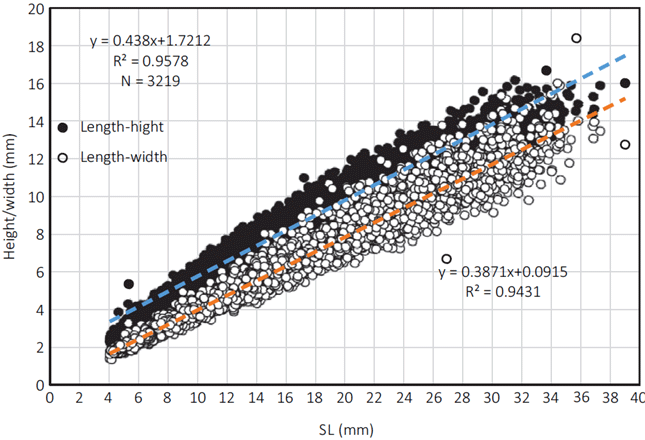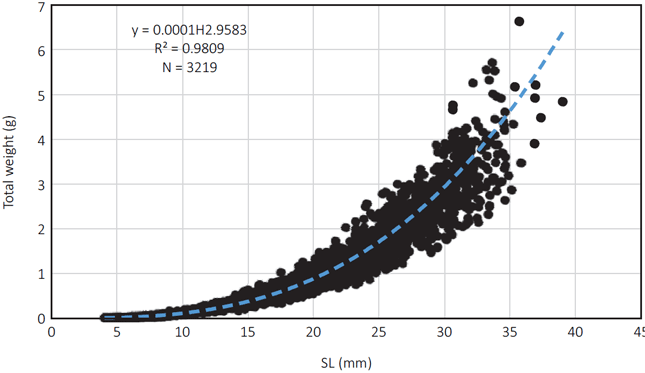Morphometric Features of the Shell Population of Brachidontes pharaonis (Fischer, 1876) (Bivalvia: Mytilidae) from Alexandria Coast of Egypt
| Received 20 Mar, 2020 |
Accepted 28 Jun, 2020 |
Published 15 Aug, 2020 |
Background and Objective: Morphometric analysis of marine mussels based on shell dimensions have been reported by many researchers for Mytilidae but few published studies about morphometric of Brachidontes species. The main objective of the present study is to detect the size frequency distribution, allometry and condition index of the Lessepsian mussel species B. pharaonis along Alexandria Coast, Egypt. Materials and Methods: In the present study, three sites were selected along the coast of Alexandria City (Miami, Stanly, Al-Anfoushy). Regression analysis was applied between different morphometric parameters such as shell length and height/width/total weight/meat weight relationships. Results: The data revealed that the shell size ranged from 0.5->36 mm in all seasons and the most abundant shell size group was (4-8 mm), which represented by high percentages during spring, autumn and winter (32.5, 27.8 and 26.5%, respectively), while the large sized individuals represented by small percentages. The monthly b values of length/height, length/width and length/total weight varied from 0.3945 in November to 0.4202 in February, from 0.3507 in March to 0.4377 in May and from 2.8257 in June to 3.0607 in August, respectively. The results showed that there are two peaks for the mean of condition index during spring, summer and autumn. Conclusion: The shell growth of B. pharaonis proves a short life cycle with spawning all year round and the abundance of small shells with high density of the population in the studied area. Regression analysis showed strong correlation between length height/width and length-weights.
INTRODUCTION
Brachidontes pharaonis (Fischer P., 1870) is a small invasive mytilid species (max length 40 mm). It is primarily from the Indo-Pacific area (South-eastern Asia). It has colonized hard substrata in the Red Sea, where it has established dense mussel mats1. In the last few decades this small mytilid has been able to colonize many intertidal habitats from east to the western Mediterranean coasts. This mussel species was not recorded in the Mediterranean Sea before the opening of the Suez Canal in 18692. It was first recorded in Port Said, Egypt, in 1876 as an invasive species. Allometry is the study of the relationship between two variables or generally, allometry is the study of size and its consequences3. The most widely used method of studying changes of growth pattern in bivalves is based on allometry4. According to Gould5, allometry of soft body and shell characters is essential to fully understand the growth of species. The constant b in the morphometric relation, indicates the ratio of growth of two variables6. Morphometric analysis of marine mussels based on shell dimensions have been reported by many researchers for Mytilidae but few published studies about morphometric of Brachidontes species such as Tanaka and De Magalhaes7, studied the shell morphology of Brachidontes darwinianus and Brachidontes solisianus in Brazil and Awaad et al.8 in Suez Canal of Egypt, studied biometric relationships for B. pharaonis.
Length-weight relationship is an important factor in comparison of growth and production in aquatic organisms. Also, the condition index is essentially a measurement of tissue weight against shell total weight. The wet and dry weights reflect the general condition of mussels6.
In the present study, data on the size frequency distribution, allometry and condition index of the Lessepsian mussel species B. pharaonis were detected along Alexandria Coast, Egypt.
MATERIALS AND METHODS
Sampling sites: In the present study, three sites were selected along the coast of Alexandria city as shown in (Fig. 1). The three sites covered about 16 Km along the coast. The sites, Miami (A) and Stanly (B) were of about 250 m and 100 m away from the coast, respectively. While Al-Anfoushy site (C) is located in the Eastern Harbor in front of Kayed Bey Citadel at Alexandria.
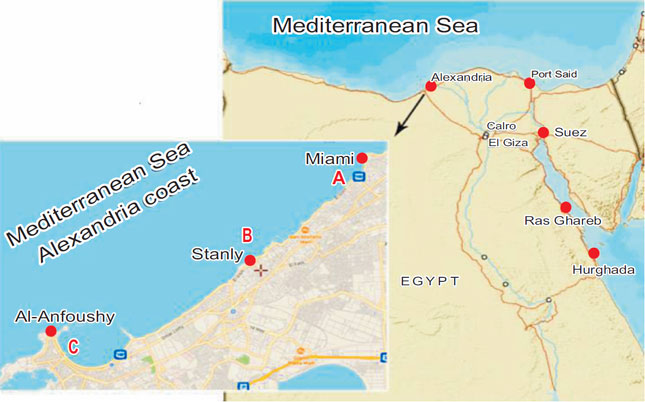 |
|||||||
Fig. 1: Map showing locations of the sampling sites for the mussel Brachidontes pharaonis A: Miami site, B: Stanly site and C: Al-Anfoushy site |
Samples collection: The samples were taken by using 1×1 m quadrat placed randomly along a 100×100 m transect. Water depth ranged from 1-6 m.
Data analysis: The total live mussel individuals were grouping into size classes using a digital Vernier caliper (0.01 mm accuracy). The number of mussels in each size group was recorded to estimate the frequency distribution of size classes. A sub sample was taken monthly from the collected mussel individuals for each site including different size groups for the following morphometric measurements:
- Gilboa, A., 1976. Experiments in mytilids recolonization (Doctoral dissertation, MS Dissertation, Hebrew University of Jerusalem, Israel).
- Issel, A., 1869. Malacology of the Red Sea: zoological and paleontological research. Malacology library, Pisa pp 387.
- Reiss, M. J., 1989. The Allometry of Growth and Reproduction. Cambridge University Press Cambridge, United Kingdom Pages: 182.
- Singh, Y.T., 2017. Relationships between environmental factors and biological parameters of Asian wedge clam, Donax scortum, morphometric analysis, length-weight relationship and condition index: a first report in Asia. J. Mari. Biol. Assoc. U.K., 97: 1617-1633.
- Gould, S.J., 1966. Allometry and size in ontogeny and phylogeny. Biol. Rev., 41: 587-638.
- Thippeswamy, H.S., 2008. Allometry and condition index in green mussel Perna viridis(L.) from St Marys Island off Malpe, near Udupi, India. India. Aquac. Res., 39: 1747-1758.
- Tanaka, M.O. and C. A. De Magalhaes, 1999. Morphometric species recognition in Brachidontesdarwinianus and Brachidontessolisianus (Bivalvia: Mytilidae). Veliger, 42: 267-274.
- El-Sayed, A., N. Ibrahim, A. Nassef, M. El-Hammady and H. El-Mekawy, 2016. Biometric relationships for the bivalve mussel, brachidontes pharaonis populations from the North-Western Coast of Suez Gulf, Egypt. Egypt. Acad. J. Biol. Sci., B. Zool., 8: 61-73.
- Devenport, J. and X. Chen, 1987. A comparison of methods for the assessment of condition in the mussel (Mytilus edulis L.). J. Moll. Stud., 53: 293-297.
- Sarà, G., V. Palmeri, A. Rinaldi, V. Montalto and B. Helmuth, 2013. Predicting biological invasions in marine habitats through eco-physiological mechanistic models: a case study with the bivalve Brachidontes pharaonis. Diversity Distrib., 19: 1235-1247.
- Sarà, G., C. Romano, M. Caruso, and A. Mazzola, 2000. The new Lessepsian entry Brachidontes pharaonis (Fischer P., 1870) (Bivalvia, Mytilidae) in the western Mediterranean: a physiological analysis under varying natural conditions. J. Shellfish Res., 19: 967-978.
- Sara, G., C. Romano, J. Widdows and F.J. Staff, 2008. Effect of salinity and temperature on feeding physiology and scope for growth of an invasive species (Brachidontes pharaonis-Mollusca: Bivalvia) within the Mediterranean Sea. J. Exp. Mar. Biol. Ecol., 363: 130-136.
- Sarà, G., M. Milanese, I. Prusina, A. Sarà and D.L. Angel et al., 2014. The impact of climate change on mediterranean intertidal communities: losses in coastal ecosystem integrity and services. Reg. Environ. Change, 14: 5-17.
- Sarà, G., S. Vizzini and A. Mazzola, 2003. Sources of carbon and dietary habits of new Lessepsian entry Brachidontes pharaonis (Bivalvia, Mytilidae) in the western Mediterranean Marine Biol., 143: 713-722.
- Sarà, G., and M. De Pirro. 2011. Heart beat rate adaptations to varying salinity of two intertidal Mediterranean bivalves: The invasive Brachidontes pharaonisand the native Mytilaster minimus. Ital. J. Zool., 78: 193-197.
- Rilov, G., Y. Benayahu and A. Gasith, 2004. Prolonged lag in population outbreak of an invasive mussel: A shifting-habitat model. Biol. Invasions, 6: 347-364.
- Sará, G., C. Romano and A. Mazzola, 2006. A new lessepsian species in the western Mediterranean ( Brachidontes pharaonis Bivalvia: Mytilidae): density, resource allocation and biomass. Mar. Biodivers. Rec.
- El-Deeb, R.S., F.A.A. Razek, H.A. Omar, A.R. Khafage and K.K. Abdul-Aziz, 2018. The gametogenic cycle and spawning of the mussel Brachidontes pharaonis (Fischer, 1876) (Bivalvia: Mytilidae) from Alexandria Coast, Egypt. Egypt. J. Aquat. Res., 44: 353-359.
- Bayne, B.L., and C.M. Worrall, 1980. Growth and production of mussels Mytilus edulis from two populations. Mar. Ecol. Prog. Ser., 3: 317-328.
- Seed, R., 1968. Factors influencing shell shape in the mussel Mytilus Edulis. J. Mar. Biol. Ass., 48: 561-584.
- Lee, S.Y., 1986. Growth and reproduction of the green mussel Perna viridis (L.) (Bivalvia: Mytilacea) in contrasting environments in Hong Kong. Asian Mar. Biol., 3: 111-127.
- Gaspar, M.B., M.N. Santos, P. Vasconcelos and C.C. Monteiro, 2002. Shell morphometric relationships of the most common bivalve species (Mollusca: Bivalvia) of the Algarve coast (southern Portugal). Hydrobiologia, 477: 73-80.
- Wilber, K.M. and C.M. Yonge, 1964. Physiology of Mollusca. Vol. 1, Academic Press, New York, pp: 473.
- Hemachandra, 2011. A study on the intertidal biodiversity of Islands off Malpe near Udupi West Coast of India. PhD Thesis, Mangalore University, India.
- Radwan, N., Z. Morsy, M. Ahmed, N. Ibrahim and S. Mohammed, 2014. Molecular analysis of Brachidonte spharaonis (Fischer P., 1870) in Egypt reveals cryptic species complex. Egypt. J. Aquat. Biol. Fish., 18: 37-46.
| • | Total shell length (mm) (SL: The maximum distance of the anterior and the posterior ends of the mussel shell) |
| • | Shell height (mm) (H: The maximum distance from the hinge to the ventral surface) |
| • | Shell width (mm) (W: The maximum distance between edges of two valves) by using a digital vernier caliper (0.01 mm accuracy) |
| • | Total wet weight (g) (TW), Shell Weight (SW), Wet Weight of flesh (WW) and dry weight (DW) by using a digital balance to the nearest 0.01 g as shown in (Fig. 2a, b) |
Regression analysis was performed between different morphometric parameters such as shell length-height and shell length-width relationships. Morphometric relationships were estimated using the linear equation:
where, a intercept (growth coefficient) and b slope (growth rate) are constants. The shell length-weight relationships were derived by using the power equation:
Also, the correlation coefficient (r) was calculated. The monthly mean of condition index was calculated according to Davenport and Chen9 by using the following formula:
$$\text{Cl} = {\text{Dry flesh weight} \over \text{Dry shell weight}} \times \text{100} $$RESULTS
Size distribution: The present study showed the seasonal distribution of size frequency for B. pharaonis as in (Fig. 3), where the size distribution of whole collected populations was ranged from 0.5->36 mm in all seasons, with the dominance of young individuals of size 0.5-8 mm shell length, while the large sizes presented by lower percentages. The most frequent size class was (4-8 mm) and presented by high percentages during the seasons of spring and autumn as 32.5 and 27.8%, respectively. Also, the size class (8-12 mm) with the highest percentage (24.3%) during spring.
Morphometric correlations: The results of regression analysis for length-height/width relationships are presented in (Fig. 4) and (Table 1) and revealed that the calculated values represented a best fit to the actual observed measurements of the thickness and height.
|
|||||||
| Variables | n | a | b | r | 95% Confidence intervals | ||
| H-SL | 3219 | 1.7212 | 0.4038 | 0.9787 | 0040.0- 004009 | ||
| W-SL | 3219 | 111700 | 118390 | 117900 | 00.904-00.0.0 | ||
| TW-SL | 3219 | 0.0001 | 317038 | 117710 | 001105-0011.9 | ||
| MW-SL | 748 | 0.00001 | 319807 | 1178.3 | 000.95-000..0 | ||
| H: Height, SL: Shell length, W: Width, MW: Meat weight, TW: Total weight, n: Number of individuals, a: Intercept, b: Slope, r: Correlation coefficient | |||||||
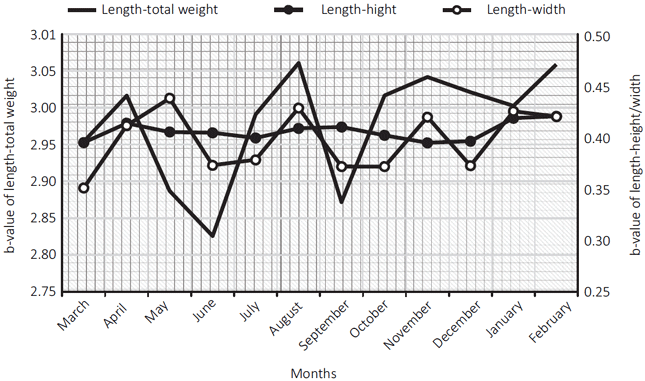 |
| Fig. 6: Monthly variability in the b values of length- height/ width/ total weight relationships during the study period |
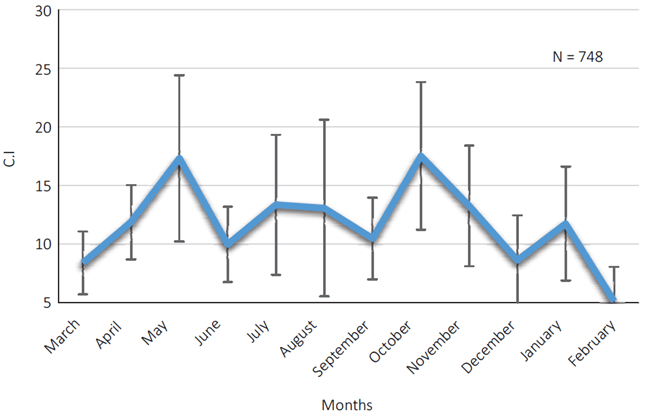 |
| Fig. 7: Monthly variation in the mean condition index±SD of Brachidontes pharaonis (vertical bars represent the standard deviation) for both sexes |
The relationships were linearly related and showed that the larger individuals were wider and thicker. Likewise, the shorter individuals were narrower and less thick. The calculated regression equations between length-height and length-width relationships for the entire study period were H = 0.4038SL+1.7212 and W =0.3871SL+0.0915, respectively. Generally, the data showed strong positive correlations between shell length-height and shell length-width relationships.
For the length-total weight relationship, the results showed that there is a non-linear pattern between two variables during the study period as shown in (Fig. 5) and (Table 1). The regression equation is TW = 0.0001SL2.9583 with a strong positive correlation between the two variables, also for length-meat weight relationship, the regression analysis as shown in (Table 1) MW = 0.00001SL2.7359 and revealed a strong correlation.
The data representing the monthly b values of length-height/width and length-total weight relationships is shown in (Fig. 6). For the relationship between length and height, the b values varied from 0.3945 (November) to 0.4202 (February), whereas the values for length-width relationship ranged from 0.3507 (March, 2016) to 0.4377 (May).While, the b values for length-total weight relationship ranged from 2.8257 (June) to 3.0607 (August).
Condition index: The monthly mean variability of condition index of B. pharaonis for both sexes is presented in (Fig. 7). The results showed that there are two peaks for the mean of condition index during May and October (17.3±7.1 and 17.5±6.3, respectively) and the lowest value during February (5.1±2.9) for the combined sexes.
DISCUSSION
The results of present study revealed that B. pharaonis is able to expand its size and colonize new environments. The habitat preference of B. pharaonis in the central Mediterranean according to Sarà et al.10 founding that some important aspects emerged from their metabolic analysis, 1-the central Mediterranean conditions are generally suitable for B. pharaonis 2-the main larval reservoir of this species is in subtidal habitat and 3-the intertidal habitats appear to be serve as sinks for larvae coming from subtidal habitats. Sarà et al.11,12 confirmed these results mussel below the low tide lower mark than on intertidal surface. This information will be important when assessing the future potential expansion of invasive species under warming conditions in the Mediterranean Sea as reported by Sarà et al.13. This species has a cosmopolitan distribution14,15. It has now become the numerically dominant bivalve, possibly out competing the native species by saturating the habitat with recruits originating from populations established in more favorable sites16.
The population size structure of the mussel bed in the present study in Alexandria city, with modal size class 4-8 mm and in Israaeli (modal size class 1-4 mm and 12-15 mm)16, in western Sicily (modal size class 21-24 mm17, while at Birzwbbugia (modal size class 15-20 mm). Generally, the distribution of shell sizes in all seasons showed that the presence of young individuals in higher percentages during the different seasons, which confirms that, this mussel species is continuously releasing gametes and formation of youngs all year round with beaks during spring and autumn and this results coincide with the periods of spawning activity of the species18. Also the abundance of the size class 8-12 mm especially during spring is related with spawning activity, where the minimum biological size for maturity ranging from 8-12 mm as reported by EL-Deeb et al.18.
In marine bivalves, growth is expressed as an increase in body size and weight, which are often used as the most proper parameters for measurements19. The relationships (length-height and length-width) showed linear patterns in the present study and also linearly related in other geographic regions indicating that the long individuals are wider (more height) and thicker and inversely, shorter individuals are narrow (less height) and low (less thickness).
The "b" values of morphometric relationships are used to compare between dimensional growth of related species or same species in varied habitats. When the two variables have the same units the "b" value equal to unity, i.e. the rate of growth of variables is same and the relationship is said to be "isometric". If the "b" value is greater than unity, it means the variable Y is increasing faster than the variable X and the relationship is known as positive allometry. The "b" value less than 1 indicates that the reverse is correct and the relation is known as negative allometry. In the present study, the relationships between length-height and length-width for B. pharaonis showed linear relations with "b" values 0.4038 and 118390, respectively. While at Ain Sokhna and Adabia, the values of b were 0.663 and 0.740 for length-height relationship and 0.746 and 0.853 for length-width relationship, respectively at the same sites as reported by Awaad et al.8.
The allometric length-weight relationships showed non-linear patterns in all sizes throughout the study period. The results showed that, short individuals were light and long individuals were heavy, thus indicating the increased weight of mussels with age. However, some individuals of the same age showed different weights and these differences could be due to the physiological condition of mussels and to the environmental factors20-22.
The variation in constant "b" represents the growth in weight rather than that of length. In the length-weight relationship, when "b" is equal to 3, the relation is said to be isometric, while is known as positive or negative allometric, when "b" value is greater or smaller than 3, respectively. Generally the "b"value lies between 2.4 and 4.5 according to Wilbur and Owen23. Length-total weight relationships in the present of B. pharaonis showed b values of 317038. The monthly "b" values ranged from 2.8257 (June) to 3.0607 (August). This means that the weight reflect the general conditions of mussels. However, the "b" values are different which could be related to reproductive cycle.
Similar observation were made by Hemachandra24 for green mussel. Awaad et al.8 in their studies on B. pharaonis reported that b value for length-weight relationship was 2.112 at Adabia and 2.376 at AinSokhna, North-Western Coast of Suez Gulf, Egypt. Sará et al.12, reported varied values of "b" for the same species from 2.0 during winter to 2.6 and 2.7 during summer and autumn, respectively. While Radwan et al.25 reported values of 2.38, 2.76, 2.78, 2.97 and 2.71 for those collected from Lake Timash, Gulf of Suez, Marsa Alam (Red Sea), Bardawil Lagoon and Port Said (Mediterranean Sea), respectively.
The values of correlation coefficient (r) for B. pharaonis recorded in the present study were more than 0.8 throughout the study period indicating a highly significant relations for (length-height and length-width) and (length-total weight) relationships.
Singh4 concluded that, spawning process depends on a complex interaction of several endogenous and exogenous factors, whereas the duration of maximum values of condition index correspond to the pre-spawning peak of gonad index. The present study for B. pharaonis, the values of condition index peaks during May and October in both sexes were observed correspond to peaks of spawning cycle. Also, smallest values of condition index during September and February were related to the lowest values of gonad index. The present data suggest a close relation between breeding season and condition index.
CONCLUSION
In the present study, the presence of higher densities of young individuals is more than the larger sizes in all the studied sites proved that the environmental conditions as well as the associated fauna and flora are suitable for its continuous breeding with higher growth of shell dimensions. The results revealed that B. pharaonis has the ability to expand and colonize new environments.
SIGNIFICANCE STATEMENT
This study reported the morphometric characteristics of Brachidontes pharaonis from Alexandria Coast of Egypt that can be considered the baseline information for the further studies regarding its distribution as it has been well established and little researched. Our results revealed that the presence of higher densities of young individuals is more than the larger sizes in all the studied sites proved that the environmental conditions as well as the associated fauna and flora are suitable for its continuous breeding with higher growth of shell dimensions. It was concluded that B. pharaonis has the ability to expand and colonize new environments.
ACKNOWLEDGMENT
The authors are grateful to Dr. Mahmoud Ahmed Attallh, Ph.D., Assistant lecturer in the Faculty of Science Al-Azhar University for his help and support during the study.
REFERENCES
How to Cite this paper?
APA-7 Style
Abdel Razek,
F., A. Omar,
H., El-Deeb,
R., Abdul-Aziz,
K. (2020). Morphometric Features of the Shell Population of Brachidontes pharaonis (Fischer, 1876) (Bivalvia: Mytilidae) from Alexandria Coast of Egypt. Asian Journal of Emerging Research, 2(3), 114-123. https://doi.org/10.3923/AJERPK.2020.114.123
ACS Style
Abdel Razek,
F.; A. Omar,
H.; El-Deeb,
R.; Abdul-Aziz,
K. Morphometric Features of the Shell Population of Brachidontes pharaonis (Fischer, 1876) (Bivalvia: Mytilidae) from Alexandria Coast of Egypt. Asian J. Emerg. Res 2020, 2, 114-123. https://doi.org/10.3923/AJERPK.2020.114.123
AMA Style
Abdel Razek
F, A. Omar
H, El-Deeb
R, Abdul-Aziz
K. Morphometric Features of the Shell Population of Brachidontes pharaonis (Fischer, 1876) (Bivalvia: Mytilidae) from Alexandria Coast of Egypt. Asian Journal of Emerging Research. 2020; 2(3): 114-123. https://doi.org/10.3923/AJERPK.2020.114.123
Chicago/Turabian Style
Abdel Razek, Fatma, Hamdy A. Omar, Rabab S. El-Deeb, and Karolin K. Abdul-Aziz.
2020. "Morphometric Features of the Shell Population of Brachidontes pharaonis (Fischer, 1876) (Bivalvia: Mytilidae) from Alexandria Coast of Egypt" Asian Journal of Emerging Research 2, no. 3: 114-123. https://doi.org/10.3923/AJERPK.2020.114.123

This work is licensed under a Creative Commons Attribution 4.0 International License.


